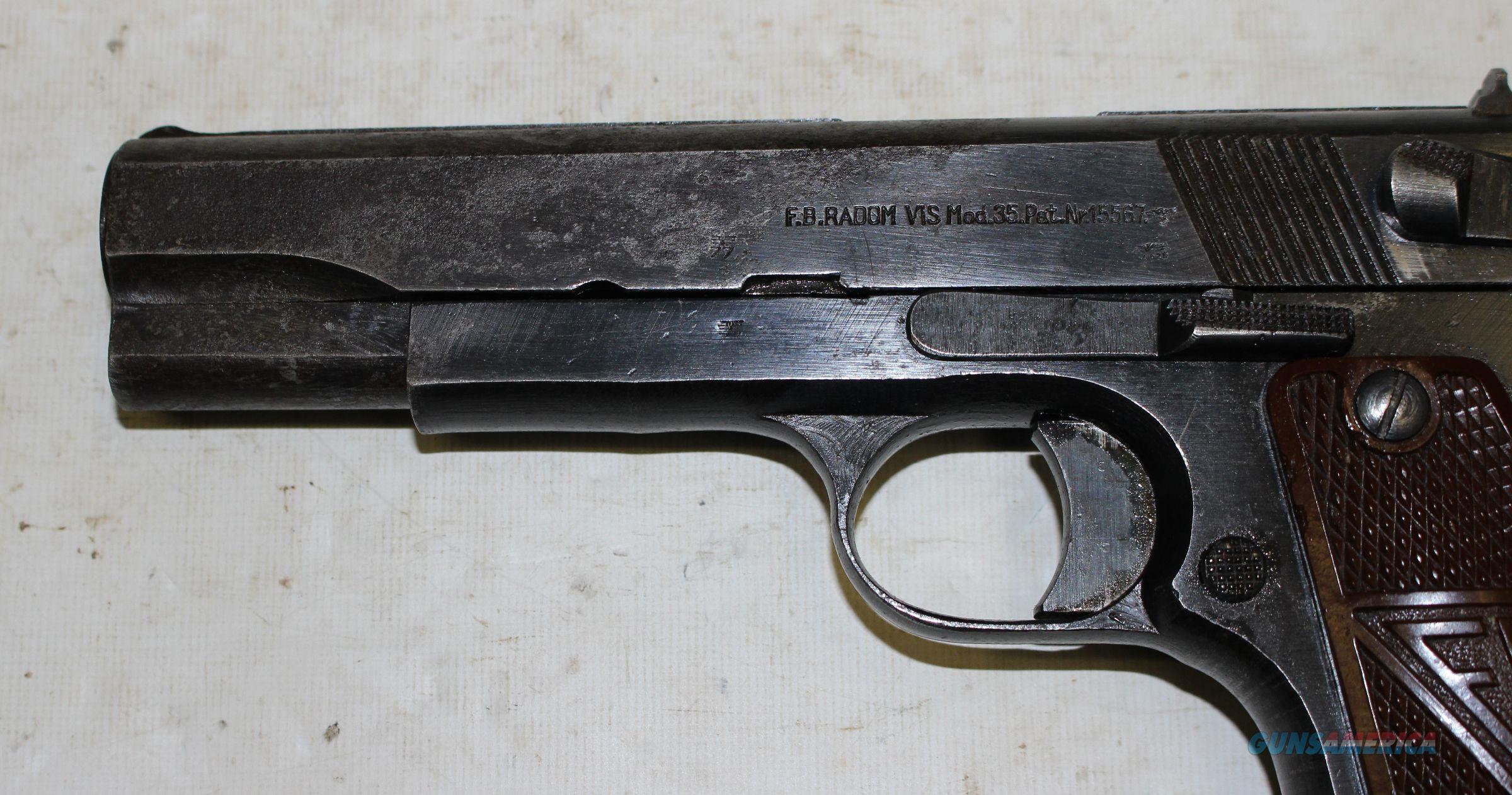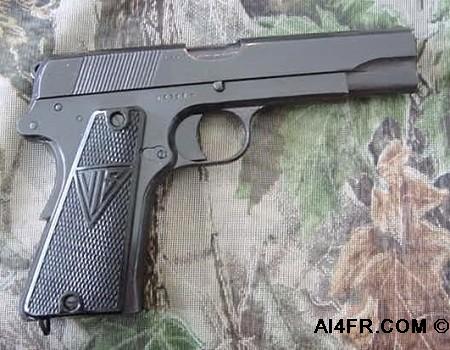LSB#: 121121TS04
Make: F.B. Radom, Polish

Radom vis model 35. P35 (a) made in 1940 serial number a8056 9mm caliber.slotted for shoulder stock, german for sale by max t france on gunsamerica - 994221644. 1/31/18 - This is a rare slotted Radom P.35 variation, with pre-alphabet serial number. There were only 12,000 of this variation produced, compared to the 47,000 later slotted Radoms produced. This scarce variation has no lanyard loop and no letter prefix to the serial number. This pistol is all matching and original with about 85% blue remaining. There is uniform thinning on the slide. 15567 'P.35(p)' Finish: military-finish; blued. Grips: black chequered Bakelit grips. On left side FB logo. On right side VIS logo. Serial number: 4-digit number with prefix on right frame. 4-digit number with prefix inside slide. 3-digit number on barrel. Acceptance stamp: E/77 left on slide. E/77 left on frame.

Advanced kp stellar astrology software. Model: Model 1939 VIS-35
- Radom p35 description: radom p35 in 9mm cal., with 4 1/2' barrel. Serial number n5477. Radom model p35, comes with one waffen marked magazine, bright shiny bore, all properly waffen marked receiver and slide which is not marked p35 (p), requires the larger grip screws, 75% overall condition, all and all a fine example of a wwii radom, our stock # d767.
- Radom Model 35 Serial Numbers. Posted by admin. Radom Model 35 Serial Numbers Rating: 3,2/5 7982 votes (Redirected from Vis pistol) Jump to navigationJump.
Serial Number: 34883
Year of Manufacture: 1936-1939
Caliber: 9mm
Action Type: Single Action Semi Auto with Removable Magazine
Markings: There are a number of light proof marks on the right side of the trigger guard and trigger. The right side of the frame is marked “34883”. The left side of the slide is marked “F. B. Radom / 1939” / Polish Eagle / “Vis WZ. 35 / pat. Nr. 15567”. There is a “D / 2” in an oval on the left trigger guard bow and another proof mark on the left side of the slide at the safety. There are characters and “34883” on the underside of the slide. “882” is on the left side of the barrel lug. There is an “E” is the stock slot cut-out.
Barrel Length: 4 ½”
Sights / Optics: The front sight is part of the rib. The rear sight is a dovetail set notch.
Stock Configuration & Condition: The grips are checkered plastic. There is a “FB” on the left panel and a “VIS” on the right. The checkering is very sharp and these panels show no splits or cracks. There is very little wear whatsoever on these panels and the screws even show fire blue. The grips rate in about Excellent overall condition.
Type of Finish: Blue
Finish Originality: Factory Original
Bore Condition: The bore is bright and the rifling is sharp. There is no erosion in the bore. Essential social psychology crisp turner pdf.
Overall Condition: This handgun retains about 93% of its metal finish. The only mentionable wear on this pistol is on the right side of the slide. There is edge wear here and scattered surface freckling. There is one more freckle on the right side of the frame. There is some holster wear at the muzzle. The edges are sharp and the surfaces are true, this is a very sharp Radom. The screw heads are only slightly marked. The markings are crisp, except for the proofs on the trigger guard bows. Overall, this handgun rates in about Excellent condition.
Mechanics: The action functions correctly. We did not fire this handgun.
Box, Paperwork & Accessories: An unmarked black military style flap holster and 2 original magazines are included. The leather is very soft and the stitching is sound. The magazines rate in about Excellent condition and the holster in about Very Good.

Our Assessment: This is an early and high quality Radom. Wikipedia: Originally designed by Piotr Wilniewczyc and Jan Skrzypinski in 1930 at the Fabryka Broni (Arms Factory) in Radom under Director Kazimierz Oldakowski, it was adopted in 1935 as the standard handgun of the Polish Army. Considered by many to be one of the finest handguns ever produced, it is highly prized among collectors of firearms. The design was generally based on American firearms inventor John Browning’s Colt M1911A1, operating on the short-recoil principle, with the barrel being cammed down and away from the locking lugs in the slide. Unlike M1911, the barrel was not cammed by a link, but by a ledge of sorts, which contacts a portion of the barrel and forces it down as it is moved rearward with the slide by the recoil force, similarly as in Browning’s FN Hi-Power pistol and Spanish Ruby 0.45 ACP. It differs from M1911A1 also in other details. Its characteristic feature was a triangular grip shape, wider at the bottom, offering good ergonomics and firm grip. On the right side grip cover, the pistol had letters VIS in a triangle, on the left side—FB (for Fabryka Broni—”Arms Factory”) The handgun was prepared in late 1930, and at the beginning of 1931 the first pistols were ready for testing. Initially it was named WiS (an acronym of the Polish designers’ names); later the name was changed to Vis, meaning “force” in Latin, with the wz. abbreviation for wzór (“model”). The tests proved that the handgun was very accurate and stable (due to its size and mass, most stresses are absorbed and not passed on the shooter); while at the same time remaining reliable after firing more than 6,000 rounds. The Vis was generally regarded as one of the best military pistols of that period. Production started in the state armory Fabryka Broni in Radom in late 1935, and the following year it was introduced as the standard weapon of Polish infantry and cavalry officers. Successively, other units were to be equipped, and by 1942 all other handguns were scheduled to be withdrawn from service. By mid-1938, it was introduced to the armored and air forces. Before the Invasion of Poland, approximately 49,400 (out of 90,000 ordered) were delivered to the army. There was also a small information series of .45 ACP version, with 7 round magazine, but they were not produced in greater series. A .22 LR variant also existed, but no details are known, and its series was not produced in great numbers. After the Polish defeat in 1939, the Germans took over the Radom Armory and continued production of the Vis under the new name of 9 mm Pistole 645(p), which was for some reason often rendered as P 35(p) (the suffix “p” means “polnische”) (the German pistols of the first series had inscriptions VIS Mod.35 and P.35 (p) on the left side). Up to 1945, between 312,000 and 380,000 were produced and used by the German paratroopers and police.
CA Legal or CA Private Party Transferable: This handgun is a C&R eligible and can be transferred/sold in California because C&R handguns are exempt from the Roster. This handgun can be sold to a California resident as a private party transaction (PPT) at our shop in Simi Valley. If sold to a California resident it must be DROSd. This does not apply to out of state buyers.
Sold For: $3,525
Radom Vis 35 Serial Numbers
- Joined
- Apr 13, 2009
- Messages
- 2,171
- Likes
- 350
- Location
- Western Maine
Fb Radom Vis Model 35 Serial Numbers
Largely considered as one of the best engineered pistols of the European WWII era, the VIS 35 was Poland's ultimate small arms achievement. Though it is uniquely patented, the pistol's design borrows heavily from the Belgian Browning Hi Power. Pre-war production (1936-1939) featured a prominent Polish Eagle on the left slide, and the guns were meticulously buffed and finished.
When the Germans overran Poland in late 1939, they resumed production at the Radom Arsenal utilizing existing inventory. By mid to late 1940, they began making new product. The Polish Eagle was discontinued, and the Germans renamed the gun as the P35(p). Early occupation production had the new designation stamped on the slide, and the pistol retained its features such as the quality finish, the shoulder stock slot in the rear grip frame, and the takedown lever. Serial numbering was changed to the typical German alphabet prefix style. The Nazis assigned the Waffenamt inspection of WaA77 (later Eagle over 77). Final assembly and acceptance was assigned to the Steyr Arsenal in Austria, with Waffenamt WaA623. Magazines featured the inspection of E/189.
As the war progressed, the Germans sought to speed production and cut costs. The stock slot was discontinued. The takedown lever was eliminated, and instead incorporated with the decocking device. The P35(p) was discontinued on the slide, the relief recesses were no longer milled behind the trigger on the frame, grip screw pillar escutcheons were eliminated, telescoping guide rod replaced with a solid rod, and the plastic grip panels were replaced with wood. Outward appearance was no longer a concern, and the polished finish yielded to the rough machined finish. The latest guns were parkerized instead of blued.
For identification purposes of war-time pistols, some collectors will follow a system of Grades I-IV to denote the feature elimination progression. Others identify by the First Alphabet and Second Alphabet serial number series. And still others call them Slotted and Non-Slotted, or Three Lever and Two Lever.
By mid to late 1944, the Soviets were advancing toward Poland, and the Germans began moving the entire VIS 35 production from the Radom Arsenal in Poland to the Steyr Arsenal in Austria.
Can't really say that I absorb all the Grade Types and Sub-variants, so I'll call mine a two lever, d-prefix from the second alphabet, no stock slot, non P35(p) legend, E/77 slide and frame, WaA623 slide, telescoping guide rod, E/189 mag, and nice black plastic grips without screw pillars.
It is an early 1944 gun and has some light high edge wear, a small rub on the right slide, a light scratch or two, and some moderate grip strap thinning. Bore is bright and sharp.
Although the lighting and exposure don't always pick up proper hue in the pics, it's a very nice dark blue with 90-plus% coverage. Machining is crude and rough, just like it should be, and just the way I like it!
My holster is extremely interesting. It began life as M1898 Austrian Rast Gasser revolver holster. It was likely modified in WWI to incorporate a shoulder harness. In WWII, the shoulder harness was eliminated, and the large trigger guard section was reduced to accept the smaller frame of the VIS 35.
This is a very uncommonly found holster design, and I have only found reference to three others with similar alterations.
The rest of the pics, and thanks for looking.
-Matt